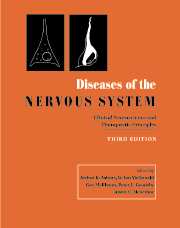Book contents
- Frontmatter
- Dedication
- Contents
- List of contributors
- Editor's preface
- PART I INTRODUCTION AND GENERAL PRINCIPLES
- PART II DISORDERS OF HIGHER FUNCTION
- PART III DISORDERS OF MOTOR CONTROL
- PART IV DISORDERS OF THE SPECIAL SENSES
- PART V DISORDERS OF SPINE AND SPINAL CORD
- PART VI DISORDERS OF BODY FUNCTION
- PART VII HEADACHE AND PAIN
- PART VIII NEUROMUSCULAR DISORDERS
- PART IX EPILEPSY
- PART X CEREBROVASCULAR DISORDERS
- PART XI NEOPLASTIC DISORDERS
- PART XII AUTOIMMUNE DISORDERS
- PART XIII DISORDERS OF MYELIN
- PART XIV INFECTIONS
- 101 Host responses in central nervous system infection
- 102 Viral diseases of the nervous system
- 103 Neurological manifestations of HIV infection
- 104 Neurological manifestations of HTLV-I infection
- 105 Clinical features of human prion diseases
- 106 Bacterial infections
- 107 Parasitic disease
- 108 Lyme disease
- 109 Neurosyphilis
- 110 Tuberculosis
- PART XV TRAUMA AND TOXIC DISORDERS
- PART XVI DEGENERATIVE DISORDERS
- PART XVII NEUROLOGICAL MANIFESTATIONS OF SYSTEMIC CONDITIONS
- Complete two-volume index
- Plate Section
104 - Neurological manifestations of HTLV-I infection
from PART XIV - INFECTIONS
Published online by Cambridge University Press: 05 August 2016
- Frontmatter
- Dedication
- Contents
- List of contributors
- Editor's preface
- PART I INTRODUCTION AND GENERAL PRINCIPLES
- PART II DISORDERS OF HIGHER FUNCTION
- PART III DISORDERS OF MOTOR CONTROL
- PART IV DISORDERS OF THE SPECIAL SENSES
- PART V DISORDERS OF SPINE AND SPINAL CORD
- PART VI DISORDERS OF BODY FUNCTION
- PART VII HEADACHE AND PAIN
- PART VIII NEUROMUSCULAR DISORDERS
- PART IX EPILEPSY
- PART X CEREBROVASCULAR DISORDERS
- PART XI NEOPLASTIC DISORDERS
- PART XII AUTOIMMUNE DISORDERS
- PART XIII DISORDERS OF MYELIN
- PART XIV INFECTIONS
- 101 Host responses in central nervous system infection
- 102 Viral diseases of the nervous system
- 103 Neurological manifestations of HIV infection
- 104 Neurological manifestations of HTLV-I infection
- 105 Clinical features of human prion diseases
- 106 Bacterial infections
- 107 Parasitic disease
- 108 Lyme disease
- 109 Neurosyphilis
- 110 Tuberculosis
- PART XV TRAUMA AND TOXIC DISORDERS
- PART XVI DEGENERATIVE DISORDERS
- PART XVII NEUROLOGICAL MANIFESTATIONS OF SYSTEMIC CONDITIONS
- Complete two-volume index
- Plate Section
Summary
Human T-cell lymphotropic virus type I (HTLV-I) is the causative agent for adult T-cell leukemia (ATL). ATL was first proposed as a clinical entity in Japan (Takatsuki et al., 1976; Uchiyama et al., 1977). The association of this disease to a new human retrovirus, HTLV-I, was discovered by independent research groups in USA (Poiesz et al., 1980) and Japan (Miyoshi et al., 1980; Hinuma et al., 1981; Yoshida et al., 1982). This same virus was found to be related to another human disease, a progressive spastic paraparesis, independently in two areas of the world, the Caribbean basin and Japan. In Martinique, 59% of patients with tropical spastic paraparesis (TSP) had antibodies to HTLV-I (Gessain et al., 1985). In Japan, a high prevalence of primary lateral sclerosis or spinal spastic paraparesis was found in South Kyushu (Osame et al., 1975). A follow-up study of this disorder established the existence of a new disease associated with HTLV-I which was named as HTLVI associated myelopathy (HAM) (Osame et al., 1986, 1987; Osame & Igata, 1989). The disease is now known under the acronym, HAM/TSP (World Health Organization, 1989; Osame et al., 1990a).
HTLV-I virus
HTLV-I is a type C retrovirus, subfamily Oncoviridae. In contrast to the human immunodeficiency virus (HIV), HTLV-I causes disease in only about 5% of infected people. HTLV-I is estimated to infect approximately ten million people worldwide. There are large endemic areas in southern Japan, Central and West Africa, the Caribbean and South America, and smaller foci in the aboriginal populations of Australia, Papua New Guinea and northern Japan. In Europe and North America the virus is found chiefly in immigrants from these endemic areas and in some communities of IV drug users. Within the endemic areas, the seroprevalence varies between 1% and 20%. The number of the patients with ATL and HAM/TSP is estimated to be more than 3000 and 5000, respectively.
There are three important modes of transmission: parental and neonatal infection from a seropositive mother, in which breastfeeding is a significant factor; sexual transmission, particularly from males to females; and transmission by infected blood, either by transfusion or by sharing of needles among drug users.Transmission of the virus depends on transfer of cells from infected people. Blood for transfusion is now routinely screened for HTLV-I in several countries, including Japan (Osame et al., 1990b), the USA and Brazil.
Information
- Type
- Chapter
- Information
- Diseases of the Nervous SystemClinical Neuroscience and Therapeutic Principles, pp. 1710 - 1715Publisher: Cambridge University PressPrint publication year: 2002
